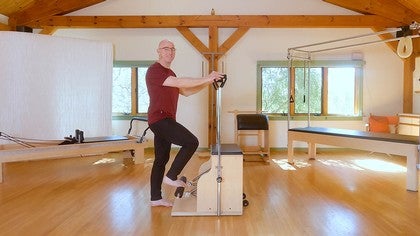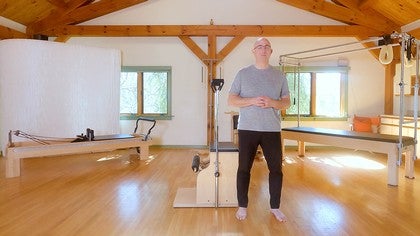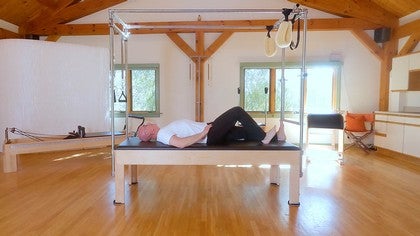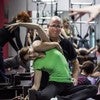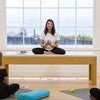Description
About This Video
Transcript
Read Full Transcript
So our first movement lab in this course is gonna be looking at what do we do to get ready for surgery. So we've already made the decision I'm gonna have a hip replacement, we've picked our surgeon, we've made that decision, we've already covered the pharmaceutical, how we're gonna manage our pain, all of those things. And now is this idea of I need to be ready, as ready as I can be for hip surgery. Now there's a catch-22 here sometimes. It's sort of like, well, I'm in a lot of hip pain that's why I need to get a hip replacement, but I also need to be in as good a shape as possible, as allowable, before I go and have my hip replaced.
And I have a number of patients for example, the doctor said, you have to lose 20, 30 pounds before I'll do the surgery with you, or the physical therapist saying, we really need to get you strong or we have to get as much mobility as we can before going in for surgery. So I have three primary objectives as it pertains to pre or prep for a hip replacement. The first one is mobility and mobility is really crucial and this is one that's sort of like, I remember having a patient he's like, why are you torturing me now before I go get my hip replacement? And the reason is because if he had just waited until he had lost the weight he needed to lose to have the hip surgery and not had the mobility, all of the soft tissues around the joint would be compromised and limited. So once the new hip is in place the soft tissue around the joint still is compromised, it's weak, it doesn't have mobility, it doesn't have the ability to function.
So it's really important that we try to maintain or to gain as much mobility as possible around the hip. And sometimes that's painful. Sometimes that hurts. And maybe that's a job that you should refer to physical therapist if it's painful We like pain. And if you mobilize into that area we're trying to get things like the rotators of the hip, we're trying to get the adductors and abductors of the hip to be more mobile so that we can rehabilitate much quicker after the surgery.
People who have failed the surgery often have waited so long and have had such compromise in other tissues around the joint that the rehabilitation process has failed. And so that's why I want to make this emphasis. In the Pilates world we're a perfect situation. So I have a number of exercises we're gonna go through in just a minute in the lab portion of this and I hope you'll follow me if you have your equipment. The second item is power.
And so we want to be as strong as we can be. We want to walk as much as we can walk. We want to squat as much as our hips let us squat. We want to be as strong as we can be preparing to go into surgery. Now that doesn't mean create massive amount of pain.
In Pilates we can use assistive devices. We can use the springs and the trapeze table which I'm gonna demonstrate for you. We can use the foot bar and be able to do footwork. All of those things, and the chair to be able to increase the strength of that hip motion while we're moving through space. And then the third one is function and I can say the fourth one is function and the fifth one is function, and the sixth one is function.
Like function, function, function. I don't do anything that doesn't increase function. So when you think of either yourself or your clients that are suffering, that's why they're gonna have a hip replacement, I look at what are you not able to do right now that you believe you should be able to do? This is a question you've heard me say in many of my workshops or webinars what do you believe you should be able to do that you're not able to do right now? And this can be things as simple as toileting, putting on shoes and socks, sitting up and standing up from a chair, getting dressed with putting a leg in a pair of pants, getting in and out of a shower, being able to get in and out of a car.
So really ask what are the functional limitations you have? And I start that education a month or two before surgery. I think that's really important. A month or two before surgery we're focusing on these functional activities. Sit to stand, preparing for toileting.
If the soft tissues don't allow you to sit down far enough to sit on a toilet, then you're gonna have a hard time toileting after the surgery. Step over a bath or a shower ledge if you're getting into the bathtub, you're gonna have to be able to do that. If we can go through and show that they're able to do all these things pre surgery then it's a cakewalk after surgery. It's so easy to be able to get in and out of a shower, up and down from the toilet, or even to start dressing in that first week or two that we'll talk about in the second lab. Getting in and out of vehicles.
When you go home from the hospital, you have to be able to get into the passenger seat of the vehicle. You might wanna think about that before and practice it with them getting in and out of the vehicle before they go in to have the surgery. Picking things up off the floor. One of the greatest things is to have a picker upper. You can have a thing that's a grasper and you get it at any store or the pharmacy stores.
And during that really early time, that first month it's great to have that to pick something up that fell on the floor and have a strategy before they do something silly and hurt themselves. And then of course I mentioned already, dressing. So what I like to do is I'm gonna start on the reformer. I'm gonna pick a few exercises that I would use as pre, both for mobility and power, and then I will tie them into function. Then we'll stop and we'll bring the chair out and the trapeze table out and we'll do the same thing with each of those apparati to be able to give some demonstrations of what I would expect in a preconditioning program.
So let's start with a reformer. I have the reformer here. One of the first things that I like to teach is the idea of sit to stand. So sit to stand could be something, a toilet is about the same height as a lot of reformers. So can they understand the mechanics of sitting with the hip opening in the back as they go down to sit onto the reformer?
It's a perfect place to practice sit to stand. And then standing up, can they lift their chest up? They can even leave their hands on their knees if they have to, to get the body weight forward and to stand up. Chest stays up, sit bones widen, knees go forward, and they sit down. And if they have the strength to do that five or six times, just even practicing before they start their Pilates exercises, and now with no hands, then they're gonna have the power and the function and the mobility after the hip surgery.
They'll have more mobility after the hip replacement than they have with you in the pre habilitation. So very important to make note of that. Once they're on the reformer, we can go into our footwork and our feet and straps. Those are gonna be the two exercises I wanna show in this particular setting. So I have two reds and a blue spring on and I have a simple basic width in my hip with the part.
And I'm just going to find a comfortable position for them. Now, for me, I had to go out a little bit wider into a little bit of external rotation. The same thing for my sit to stand I had to go a little bit wider and that's okay. Find a comfortable place for them that they can have an angle of 90 degrees at their hips which should be equivalent to them sitting on a toilet. And then just simple footwork.
Now, one of the things I'm looking for in this early phase is whether or not the pelvis is tilting as they come down. It's very common with hip pathology that it's difficult to maintain that neutral pelvis descending down into the squat. And what's interesting is as we warm up in this preconditioning workout, we start finding that we can bring the legs into more parallel. And the key is thinking that the femoral head is dropping down into the carriage as we flex. We wanna feel that spinning down and back as we come in.
And that helps open up and also strengthen some of the muscles of the hip and the buttocks. And then from here we can start narrowing the gait a little bit and bringing in the external rotation into a little more parallel. And again what you might find is they can't go down quite as far and still stay honest with the position of their pelvis. So only go to the place where they nick that restriction and then back out. Sometimes individuals prefer heavier springs to be able to assist them down into the squat to get the range of motion.
So don't hesitate and let them feel and try what happens if I put a heavier spring on? If I make it two reds and a green? It's definitely not as heavy as their own body weight so I'm not really worried about that. But some people feel that the more pressure, it's sorta like the heavy blankets these days that the weight actually causes a relaxation of the capsule and allows a deeper squat and a little more muscle engagement. Others might not tolerate the pressure and you're gonna have to go lighter with two red springs or a red and a blue.
And eventually what I'm trying to do in footwork is to start internally rotating my hips. And you might ask, why would you go into internal rotation in fact you know is gonna be their most irritating? And you're gonna find that their range of motion is very limited. But it's in this range of motion that the femoral head has its greatest posterior glide that is going to give you the most range of motion in your hip. And then from there everything's choreography.
You can bring them back into parallel or a little bit of turned out, the ball of the feet, running exercises. Another one of my favorites is to go onto the ball of feet and wrap the toes around the bar a little bit, they've often lost dexterity in their feet and they have to regain it, let the heels drop down underneath the bar. Stay there for a little bit. And I know that I've taught this before on Pilates Anytime but if there were three areas that I would focus on in any kind of orthopedic problems would be ankle dorsiflexion, hip extension and internal rotation, and thoracic extension. And because we're dealing with a hip pathology it makes sense that we would wanna work on the ankle dorsiflexion and on the thoracic extension as well.
So that would minimize the stress through the hips. From here with the heels sending down keep sending the energy down through the heels as you bend the knees up towards the ceiling. And the reverse when you push out lead with the heels underneath the bar as the initiator of the knee extension. And what you'll find out is you start activating the backside of the leg not so much the quads. And this is gonna be very good for them when we come back into lab two and we get back onto the, or lab three we get back onto the reformer two weeks after the surgery that them having this memory is going to be very helpful to keep them out of over recruiting the hip flexors and the quadriceps.
Very important. And then from here, we can go up into heel raises which will be one of our first exercises after surgery and we can go into there with full running and alternating steps, et cetera. So all of these are preparatory. And if you have good purpose increasing ankle dorsiflexion, increasing posterior leg and hamstring activation, increasing range of motion in the hip. The next exercise is mainly for mobility, but it also has to do with power and one of the contraindications of an anterior hip replacement is long lever against gravity.
So in this case with feet and straps, I tend to go a little bit heavier with the springs to be able to minimize the load that would happen in the hip flexors. It's not that the joint itself is unstable after the surgery, as much as it is that the muscles that were separated and sewn back together again are the hip flexor muscles. So the tensor fascia latae, the psoas is right next to it, the iliacus, we want to minimize the load on that for at least two to four months after surgery. Very important on the anterior approach. So I'm gonna go into feet and straps, and I'm gonna stay with two reds for my body weight.
You would wanna make sure that the springs are set primarily to help hold the legs up. You're not thinking of getting an abdominal exercise with this particular variation of feet and straps. We're thinking more of getting flexion, and we're also think of getting longer hip extension through the straps. So let's demonstrate that one. So once I have them in that 45 degrees sort of safe space the spring should be doing all the work.
There should be no activation here and the 45 degrees should be a very safe space for our clients. And one of the things that I like to do in this exercise before I go into a straight leg is just simply have them stay on that same trajectory now bending the knee in towards the head and back out. They're not gonna be able to do a deep squat and you might find that you got to come out here a little bit wider and you might have to turn out a little bit to have the clearance to be able to get that range of motion. What's the function of it? I need them to be able to sit on a toilet.
I need them to be able to have the strength to push up and come out of a chair. So I start out in that comfortable physician for them and I gradually work my way back into a parallel. And if you wanna be a little more aggressive in the pre-program you could even go a little bit into internal rotation. Again, anytime you go internal rotation you're gonna be loading through the rotators of the hip, the piriformis, the obturators, the gemellus. You're gonna be working through those as well.
From there, we can then go into a straight leg and the straight leg again, being very cautious that we don't wanna go into a range that forces the pelvis to move yet. We wanna stay in a very controlled environment for them. And remember, they're having pain. They're gonna have surgery in a month. So what we're doing is just trying to think of more lubricating.
You're treating it as an osteoarthritic condition where movements in a safe range of motion provides the greatest pain relief in arthritis. So we wanna stay away from really deep end of ranges with heavy loads. So either go into a deeper range of motion with greater assistance or less assistance in a smaller range of motion. And again, there's really no limit here as to what they can do other than their discomfort or their range of motion. And we're just trying to lubricate, get muscles working preparatory for the surgery in their body.
And we can go into a couple other variations at this stage of the game of pre and we can work with walking on the ceiling. And again, what they're going to appreciate is that one side is probably gonna be moving better than the other side. And so they can listen to their body. And this is a good time to ask them, what do you feel? What do you notice different about the right side from the left?
And you can change the angles. And the nice thing with this is when they come back in a month after their surgery you can ask the same question again. Do you notice any difference? Some of the differences might be things like, it feels like some other buddies, somebody else's leg or somebody else's hip. That's common, good.
Or what do you notice about it? Do you like that new person's hip inside of you? Is it okay? Does it hurt? No.
Does it have movement? Yes. Good. Well, let's adopt it. Let's make a part of our body and let's be whole with all those different exercises.
So that concludes the feet and straps variation. So as you are thinking of the exercises there really is no limitation in your pre-surgery program. What I wanna bring out is attention to how I demonstrate that with a couple of reformer exercises and we'll do the same thing now with the trapeze table and with the chair. So after moving the trapeze table in place again, I wanna go back to the idea of function and the reformer you notice was much lower than the trapeze table. So this is where I've had some patients that can't get up and down off of the trapeze table.
They need the 24 inch reformer, or sorry they can't get up and down off of the reformer. They need a 24 inch clinical reformer. And this is also a place that we can practice our sit to stand. So somebody who could not sit and stand from the lower height would tell you two things. One is they're probably gonna need one of those raised toilets if they can't do that in the beginning and eventually progress to a lower toilet, or they're gonna need assisted devices to be able to get down to the toilet, probably with their leg extended out straight to a side or something.
So here's another nice place to practice sit to stand. We talked about. So again, just really focusing on alignment strengthening them so they're not using their hands. Can they do 10, 20 of those sit to stands off of the trapeze table, a higher table to be able to get that strength? The first exercise I wanna show on the trapeze table is actually one they can do at home and it's a quadruped exercise and again, it's to facilitate mobility into the hip.
And the way that we do that is starting in a quadruped position and I start with the knees out wide. And the feet can come together and I wanna get it so that the pelvis again is in a neutral position. So if I could put a cup on top of the sacrum that cup of water would not spill. And they're just gonna be hinging back and coming forward. Now the least impactful orientation of the hip is going to be hips in abduction and external rotation is where they'll get their greatest range of motion.
So our goal is to move towards parallel and towards internal rotation as it continues to go back and forth. And I refer to it as nicking the resistance. So we don't push into the pain, but they nick that resistance and go back and forth. And what you'll find is after doing it five to 10 repetitions in each position you're going to get a little more range of motion. So starting here just simply coming back into a hinge and forward, hinge back.
And you'll also notice that each repetition they can get back a little bit further. Even though they have some restriction, even though there might be some arthritic popping and noises that make and get a good five or six repetitions there. Now, from there, I'm going to go into parallel legs. And in parallel legs, same thing, pelvis in neutral going back, they're not gonna go as far. It's only gonna go back maybe half this far.
And that's because we are closing the capsule of the hip. But this is still very good for them. Again, it's based on their sensation and not on their range. And they can start sort of pushing in to that space with their hands still trying to keep the pelvis from rolling back. So it's not going into a prayer stretch or a child's pose as much as it is just going back until they feel that resistance.
And again, five to 10 repetitions here, feeling that space, particularly in the joint. They're gonna feel a little bit of resistance, more than likely anteriorly and that's okay. If they feel a stretch in their buttocks that's even better. That's telling you that that's a soft tissue restriction and not a joint restriction. From here the third position is going into internal rotation with the hips.
And I still have a fair limitation in my internal rotation. But here again, you're gonna find that the range of motion has even been decreased more. So getting the pelvis to be in that flat position all the organization you would do with your normal quadruped and now you're just nicking and touching that space. And again, it's not so much as a core exercise here as much as we're looking at a mobilization exercise. So I would be a little more tolerant of things like if they drop to their shoulders or their head drops.
It's always good for them to have that awareness, but we're really focusing on that hip mobility. Now, once they've done five or six of these they start noticing they get more range. You go back to parallel and you'll realize that you've increased your range of motion by another maybe 10 degrees of flexion. And this is an exercise that I like them to do all the time. They can do this at home, they can do it before they go to bed, they can do it when they wake up and just increasing that range of motion in the quadruped position.
The next exercise on the trapeze table is the spring assisted squat. You can do this with a chair behind it but as we come around to the backside of the trapeze table we can grab hold of springs or a dowel, heavier spring sometimes are better. I have a set of purple, long springs here for me and I'm gonna go back just far enough till I feel the tension, lift my arms up and I'm gonna squat down and back. My goal is to keep my upper body nice and straight and to really feel myself able to go down. The springs are helping me.
And so everybody's a little bit different. One thing that I'd done with some of my clients especially elderly is I put a chair behind them and I have them doing the spring assisted squat just to where they touch the chair and they come back up out of it. They touch the chair and they come back out of it. And again doing enough repetitions that we're actually increasing the strength in their hips and their buttocks muscles. They're going to want to go into this kind of a position.
You'll see them going. They're gonna go sit down, they're gonna tuck their bottom underneath and they're gonna put a lot of pressure through their quadriceps and their knees. And we wanna teach them to basically spread the sit bones as they're going down and to allow the hips after we've mobilized them to come down so they're nice and straight. So they're really focusing on using the glutes and the rotators in their squat and their stand. And again sometimes the ankles don't have enough dorsiflexion.
And what I found to be very helpful is to take a half roll or a couple pads or a rolled up yoga mat and place it underneath their heels so that they eliminate the restrictions from the ankle dorsiflexion and you'll find that some of them actually have a much healthier squat going down and coming up. So that concludes the exercises for the trapeze table. And again, remember that you have a full array of your exercise programming that you can perform with the trapeze table and the entire repertoire. It's just looking at very specific things that they need prior to surgery. So all of our programming, great whole body exercises all are beneficial to them with specific emphasis on mobility, power and function.
So the last piece of equipment I want to demonstrate for lab one, looking at restoring mobility, power and function is the chair, the combo chair. And I love this piece of equipment for my own hip. I've used it extensively in my preparation and also post. It makes me feel the best, especially with thinking of things like going up and down stairs, sit to stand, squatting, all of those activities. Really great place to learn it.
I also think that once the patient or the client understands how to use the chair before surgery it's so much easier to work with them after surgery with things like the single leg press. And that's where I'd like to start. So in standing I have two relatively light springs, the two white springs but I have them all the way up on the combo chair. And what that does for me is it provides enough load to be able to get me engaged. Like I feel like I'm not gonna fall down forward.
And if I hang on too tight with my hip muscles and pelvis muscles, it's going to send me back. So hands-on here and getting them to lean forward in their standing legs so that their body's nice and straight and well-organized, and then again, we go after that hinge. So we're looking at do they maintain that nice axial length, do they organize their torso well, and can they allow that spring now to bring the knee up? And that's what I'm thinking now as the knee is coming up the image I wanna create is that the femoral head is spiraling down and back. So it's sending the sit bone down on the weight-bearing side.
And again, we can modify this. If they can't do it with their leg in parallel maybe we can do it with them in a little bit of external rotation. And they might find that it's a little easier out here than it is in parallel. The thing here is you gotta be careful that we're not tilting to the side. So again, my cue often is to send the leg that's bending sit bone down and allow the fold to happen here.
And this is sort of acting like your physical therapist. This is what I would be doing with you if I had you on a table laying on your back is I would be pulling the pelvis down and pushing the knee up to get range of motion. And again, doing this repetition here and then gradually working our way into parallel, and then eventually being able to not use hands. That tells me that they now are coordinating their balance and stability muscles, not just on the leg that they're mobilizing but also on the stance leg. From this series here, and we can just do our repetition so we get it in, but a good 10 repetitions is great on this.
And again, you can play with the foot. You can give them things like we're gonna be doing some heel raises immediately after surgery on the same day of surgery. So giving them the feel of how to use some of these muscles that they forget about. When you're in chronic hip pain, you forget that your ankle has a problem. You forget how the knee works, how the ankle works, how your back works, and you're just surviving.
So bringing attention to other joints, fantastic way of getting them to prepare for surgery. Now you notice that I'm switching legs. And if this was my affected leg I also want to be working on my ability to maintain stance and balance on the effected side. It's not always just mobilization. Now we're looking at power.
So how do I get the power to do this? If I have a lot of pain in that hip I'm often gonna drop out to the side. So you'll see people in their function when they got to do things, they'll be here. They try to get the leg away and they try to put all the weight on the unaffected leg. So now they can't cheat like that on the chair.
That's what I love. I love when you take cheating away from them. So here you have your touch. And then you're gonna try to get them to take the touch off and be able to sustain themselves on that affected side without collapsing or losing their balance. So a very powerful exercise.
Then the variations come into play. And I love the variations on this as well. So now by changing my angle, this is very functional. This is getting in and out of a car. They're gonna have to get in and out of a car.
And I talk about these things with them. So it's like saying we're doing this exercise because this is functional. When you get the first day after surgery you're gonna go home and you have to be able to put your leg in a car, sit down, bring your other leg in the car and then bring your legs around to sit functionally. So this is a very functional exercise for them in the abduction, a little bit of external rotation. Same thing, everything applies sit bone down, strength on that leg needs to be there and then you'd do the opposite facing the other direction to get the same experience on that leg.
The other thing I love about the chair in this particular setting is because we've talked about sit to stand so much is the sitting component of this on the chair, the sitting exercise, or sitting leg press. And again, it's a great mobilization tool. So they're gonna organize their pelvis to keep it long axial length. What we wanna avoid is dropping back into the hip flexion and making it a lumbar flexion exercise and see if you can make it a hip flexion exercise. One of the biggest challenges here is if they don't have very much range of motion you don't really have much play.
So I've had some clients, they can't do that. So what do I do? I lift their bottom up. I can use a yoga block, a yoga mat, a half foam roller, anything to give you about another two, three inches equates to about 10, 15 degrees. And that's all you need to be able to nick that joint and to be able to create that range of motion for the net challenge.
That concludes the exercises for this lab. But what I wanna bring your attention to now is the mindset. And this is very important when we're preparing our clients to go into surgery. We've talked about giving them mobility, power and the function like how do I put my shoes on? For example the exercise we just did, sitting, is a great one for them to realize how to get their leg up to put their shoe on.
If they can get their feet up to here they can put their shoes and socks on. They know what that range is. They can know how to do a sit to stand on all of these exercises we've done. How to squat to get in and out of a car, how to get onto the toilet, exactly. So the mindset now becomes very important.
Can I convince or give an experience to my client that they are prepared as they can be to go into surgery? That they understand the nature of the surgery, all the things we talked about they've had their communication with their doctor, they know what kind of surgery they're having, we've removed as much of the risk of fear-based pain by giving them knowledge, by giving them strength, by giving them understanding of what to expect and to let them know through positive language that they are ready and that they're going to do well and that they're going to feel so much better when they have a new hip. And you can say that because 99% or 98% of people who have total hip replacements today have a positive experience within a couple of weeks after the surgery. That doesn't mean there isn't any pain. It means they are going to feel so much better very shortly after their surgery.
So this concludes the preparatory lab and we'll come back when we see you after surgery.
Me and My New Hip: with Brent Anderson
Comments
You need to be a subscriber to post a comment.
Please Log In or Create an Account to start your free trial.
